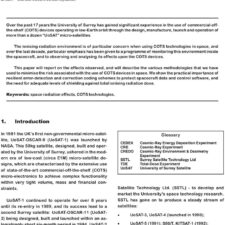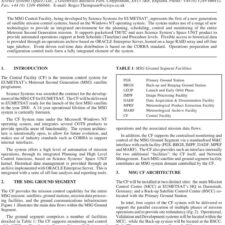Future Geostationary Earth Observation Systems
£5.00
R. Munzenmayer; H. Bovensmann; B. Grafmuller; R. Mager; T. Reinert (2008), JBIS, 61, 78-90
Refcode: 2008.61.78
Keywords: Meteosat Third Generation (MTG), Global Monitoring of Environment and Security (GMES), Sentinel 4, Geostationary Orbit (GEO), meteorology, atmospheric chemistry
Abstract:
EUMETSAT and ESA have initiated joint preparatory activities for the definition of the Meteosat Third Generation (MTG) geostationary system that needs to be available in the 2015 timeframe as a replacement for the Meteosat Second Generation (MSG) system. Based on the first outputs of the EUMETSAT post-MSG User Consultation process initiated in 2000, ESA and EUMETSAT have started pre-phase A studies at instrument and system levels with the support of industry and representatives of the user and science communities. Early 2006 Astrium GmbH completed one of the Pre-Phase-A system studies with the preliminary definition of possible mission and system concepts. Beside EUMETSAT’s need to have a replacement for MSG there are also ideas to have an additional operational system in GEO in the frame of the EU GMES (Global Monitoring of Environment and Security) program. For this program currently 5 satellite systems, called Sentinels 1-5 are proposed. For Atmospheric Chemistry applications a LEO component Sentinel-5 and a GEO component Sentinel 4 constitute the preliminary definition. First dedicated system studies concerning Sentinel 4 and 5 are expected in 2006. Obviously between MTG and Sentinel 4 there are synergies and a coordinated approach is needed, e.g. in EUMETSAT user needs also the atmospheric chemistry applications are addressed, namely the UVS (Ultraviolet – Visible – Sounding) mission. Furthermore, there were already different mission proposals in the frame of the ESA Earth Explorer Programme regarding Atmospheric Chemistry from GEO (e.g. GeoSCIA, GeoTROPE and GeoTROPE-R proposals). Additional ideas regarding Microwave Sounding missions from GEO were also proposed, which would be very interesting for the meteorological community but due to the lack of maturity the microwave sounding mission it is not an element of the MTG program. This paper provides a short overview of the different proposed missions and the relevant instrument ideas are presented based on the experience gained by Astrium GmbH in performing the corresponding studies and proposals for ESA and DLR.





